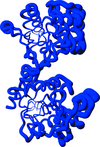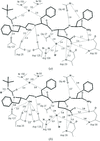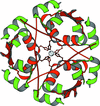issue contents
May 2006 issue

Cover illustration: Ab initio found molecular envelopes for three independent dimers of lectin SML-2 superposed with heavy atoms of a Pt derivative (p. 533).
research papers
X-ray and EM data, together with normal-mode analysis of molecular templates, are used to obtain a molecular-replacement solution for crystal structures containing multimeric flexible molecules.
The crystal structure of T4moC from the toluene 4-monooxygenase of P. mendocina KR1 has been determined at a resolution of 1.48 Å. Structural analysis and comparison of T4moC with other structurally characterized Rieske-type ferredoxins is reported.
PDB reference: T4moC, 1vm9, r1vm9sf
The first X-ray structure of the catalytic nucleotide-binding subunit A of the A1-ATPase has been determined at 2.55 Å resolution.
PDB reference: A1-ATPase A subunit, 1vdz, r1vdzsf
Structures of HIV-1 protease in complex with pseudopeptide inhibitors give new insights into the influence of the R/S configuration of the isostere and its hydroxy group on the efficiency of hydroxyethylamine and ethylenamine inhibitors.
A vesicular stomatitis virus protein oligomer complexed with RNA has been crystallized and the diffraction limits of the crystals improved by a simple soaking procedure. The internal symmetry of the oligomer and size constraints were used to determine the crystal packing arrangement.
Open  access
access
 access
accessDespentapeptide (des-B26-B30) insulin (DPI), an active modified insulin, has been crystallized in the presence of 20% acetic acid pH 2. A crystal structure analysis to 1.8 Å spacing (space group I222) revealed that the DPI molecule, which is unable to make β-strand interactions for physiological dimer formation and is apparently monomeric in solution, formed an alternative lattice-generated dimer.
PDB reference: despentapeptide insulin, 2ceu, r2ceusf
Crystal structures of 2,4-dinitrophenol bound to wild-type TTR and to two amyloidogenic variants, TTR L55P and TTR Y78F, have been determined. The structural features responsible for the interaction between 2,4-dinitrophenol and transthyretin and its stabilizing effect on the protein is discussed.
The adaptability of two novel oil- and water-based cryoprotection reagents has been examined for the cryoprotection of crystals of five different proteins. Use of these versatile cryoprotectants in the presence of heavy-atom reagents allows rapid and efficient preparation of heavy-atom derivative crystals.
The crystal structure of the red fluorescent protein zRFP574 from Zoanthus sp. at 2.4 Å resolution has revealed a novel chromophore with a decarboxylated side chain of the chromophore-forming Asp66 residue.
PDB reference: zRFP574, 2fl1, r2fl1sf
The connectivity-based ab initio phasing method was applied to obtain the first low-resolution crystallographic images from crystals of the lectin SML-2.
The structure of alcohol dehydrogenase from E. histolytica has been determined at 1.8 Å.
PDB reference: alcohol dehydrogenase, 1y9a, r1y9asf
The crystal structures of three mutants of L. casei folylpolyglutamate synthetase have been determined, along with the structure of the apoenzyme. The mutation of Gly51 to a serine at the ATP-binding site results in a major conformational change in an adjacent loop (the Ω-loop, residues 72–82). This structural rearrangement results in an inactive enzyme and points to the critical role played by the Ω-loop in both magnesium and folate substrate binding.
short communications
A new system is described for rapidly screening the effect of temperature on protein crystallization.
The inactive variant C60S of Mycobacterium tuberculosis thiol peroxidase shows the reduced form of the atypical 2-Cys peroxiredoxin.
PDB reference: MtTpx, 1y25, r1y25sf


 journal menu
journal menu

































